Forgotten New York, as of March 2014, has been around 16 years, and I’m glad I’m still alive, well, and contributing. Since I’m almost discussing the site in terms of decades now, I’ve been going through envelope after envelope full of photos taken beginning in 1998 and re-scanning several worthy ones from that time.
One thing I noticed right away, and that you may agree with if you look at some of the pages I composed in PageMill in 1998 and then brought into WordPress later, retaining the old scans, is that I was a horrible photographer in the old days. I was using a little film point-and-shoot with no zoom at all, and when something was mounted far away, I’d scan it at 300% or higher and hope for the best. Needless to say that didn’t produce very many good results. I wobbled the camera and never compensated for shadows.
So when fortune came my way (a rare occasion) and I got the chance to do Forgotten New York the Book for HarperCollins in 2003, I set to work re-photographing all the 650 selections for the book using a slightly better point-and-shoot that did have a zoom (a Canon Sure Shot) and the results are in the book, which came out in 2006.
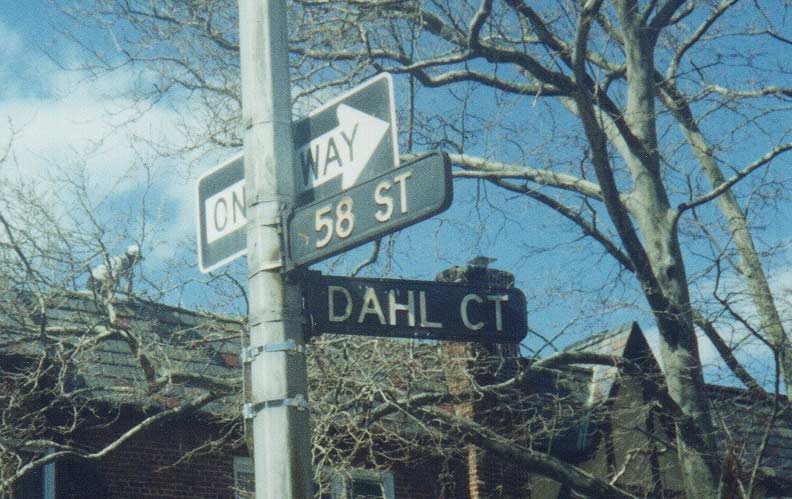
Dahl Court is one of Borough Park, Brooklyn’s few breaks from its monotonous overall rid of numbered avenues and streets, on 58th Street just west of 19th Avenue, near Washington Cemetery. It appears on maps as early as the 1920s and is a dead end lined with attached Tudoresque buildings, its sidewalks lined by London plane trees. It was originally a private development built by the Dahl Development Company in 1927.
When I first started my FNY surveying in 1998 I was aware that the court had retained a pair of porcelain and metal signs, black with raised letters in Highway Gothic, from hundreds of bike rides I had done throughout the region when I lived in Bay Ridge. The signs were likely installed in the 1940s or early 1950s; I had seen similar signs in Staten Island (black and gold) and the Bronx (blue and white) on bus rides.
Before the larger vinyl and metal signs started taking over in 1964, Brooklyn street signs looked like this, or instead, ‘humpback’ signs with the cross street in the hump (see below).
These signs had disappeared and had been replaced with standard green and whites around 2000.
A Curious Case in the Bronx
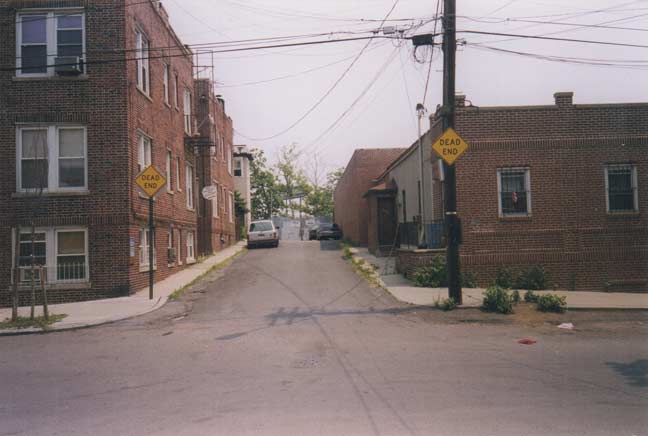
Allen Place is a dead-end on DeLavall Avenue just south of Boston Road in Eastchester, Bronx. It doesn’t show up on any NYC printed map in my collection, though Google Maps duly shows it. ForgottenFan Don Gilligan, an area resident, tipped me off to something unusual about it. Look closely at the utility pole on the right, above the DEAD END sign.
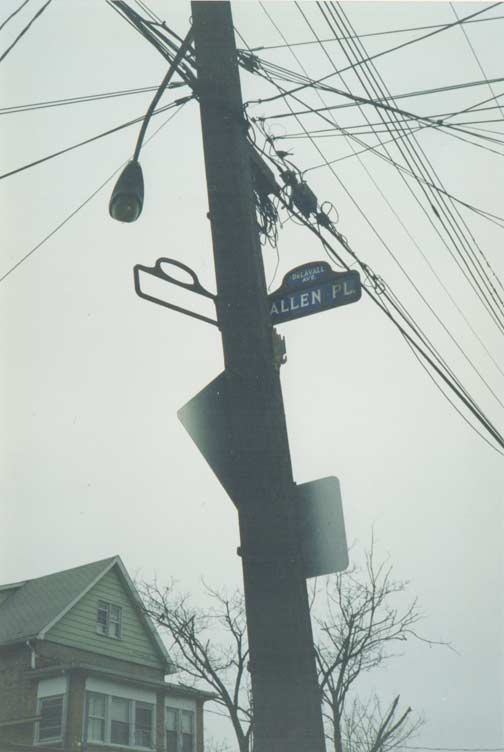
This was, no question, the last street in Manhattan or the Bronx to carry the boroughs’ distinctive navy humpback signs with serifed white lettering, with the cross street in the ‘hump.’
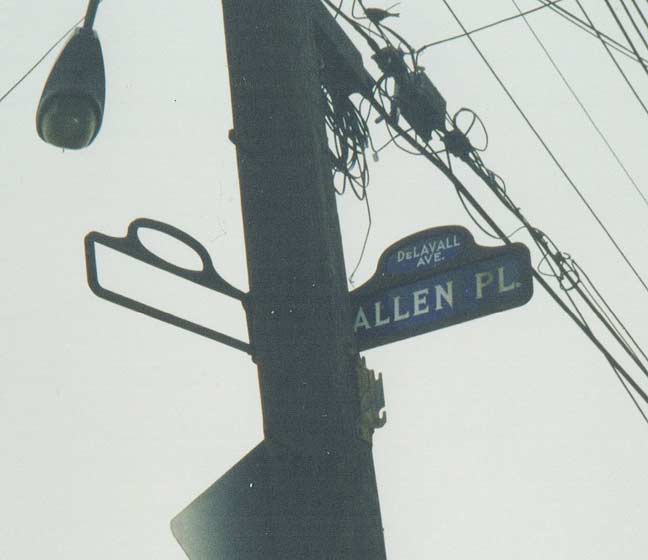
This isn’t the greatest shot in the world, but I re-scanned it and cropped out everything else. The signs were mounted unusually, with the attachment that usually went on castiron posts that held both signs nailed onto the telephone pole! In fact, you can see a bracket for an individual sign underneath the sign. Lengthy sign history here…
These signs were first installed on lampposts in 1913 or so in both Manhattan and the Bronx, which were different boroughs but the same county that year, so both boroughs got the same type of street signs! Bronx became an independent borough in 1914. The ‘humpbacks’ began to disappear from Manhattan and the Bronx as early as the 1950s, but some hung on till the late 1960s. This one, in a northern Bronx outpost, lasted until about 2000, like the Dahl Court sign.
Most streets in this part of the Bronx are named for NYC mayors, and that’s the case here too. Allen Place was named for Mayor Stephen Allen, whose grave I had visited at the NYC Marble Cemetery in spring 2014. On that page I wrote…
You can’t miss Stephen Allen (1767-1852), the 55th NYC mayor from 1821 to 1824 and a sailmaking entrepreneur before entering politics; his vault is marked by a large tapering shaft topped by a globe just to the left of the cemetery entrance on East 2nd Street.
He headed a committee that sought additional sources of drinking water, eventually focusing on Rye Pond in the future borough of the Bronx, and a potential canal to be built in Westchester. Allen and the council were raring to move forward, but state bureaucracy, yellow fever outbreaks and focus on the Erie Canal would delay the development of a viable aqueduct for many years.
Allen made a bigger impact on New York’s prison system as a member of a state committee that inspected conditions at the first state prison in Auburn, New York. Their evaluations eventually led to the construction of Sing Sing prison.
He left office after three years as mayor, but he didn’t leave politics or Tammany behind, eventually becoming a state senator and helping raise money to build the first Tammany Hall.
He spent his latter days at home on Washington Square, but tragically, he did not end up dying peacefully in bed here as other future mayors would do. He was aboard the steamship Henry Clay in July 28, 1852 when, after an ill-advised race with another vessel, it caught fire and crashed on the Hudson River, killing dozens of passengers including Nathaniel Hawthorne’s sister, famed landscapist Andrew Jackson Downing and, sadly, our former mayor Allen. Bowery Boys
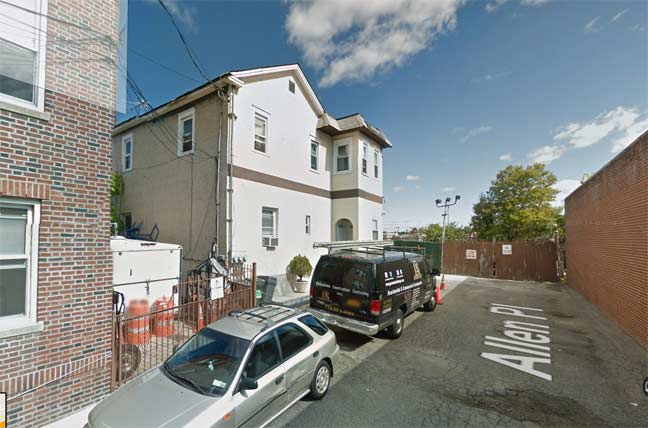
I’d have to doubt that more than a handful of local denizens know that their streets were named for NYC mayors, and the mapmakers were apparently completely unaware of Allen Place at all. Why has it been preserved all these years? It’s got exactly one residence, seen here.
2/16/15

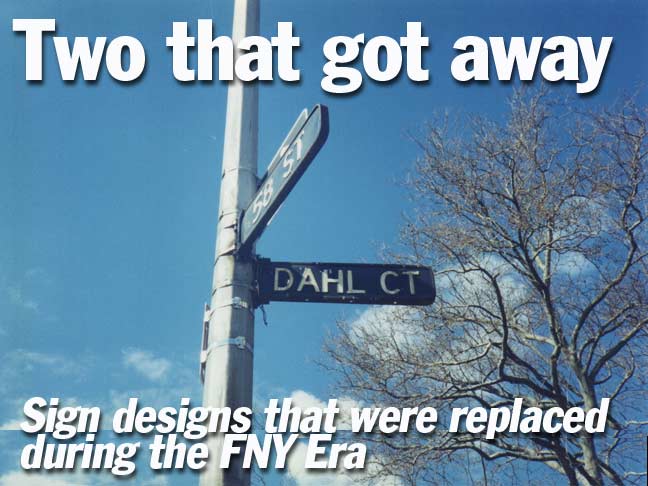
10 comments
I don’t think the Bronx ever had any porcelain street signs, just humpback signs like the one you showed for Allen Place.
The Bronx did have early porcelain street signs from the turn of the 20th century. Prior to when the first “humpback” signs appeared in the late-1910s.
I had a one of a kind street sign, Bronxdale Ave. and Kinsella st. as the cross st. It was a porcelain sign. I wish I kept it. The sign man gave it to me when they replaced it with the blue and white sign in 1969. I also had the cast iron frame, although it was in very poor condition.
It’s funny how you discover new things about the old neighborhood that you thought you knew so well! I grew up on 51st Street in Brooklyn. I rode my bike in the empty lot at 58th Street and 19th Avenue where FDR HS is now. I walked my dog past the Dept of Sanitation garage on 19th Avenue all the time. I delivered the World Telegram & Sun throughout Borough Park. Yet I don’t ever recall seeing, or being on Dahl Court, and I was frequently less than a block away!
Your dates are a little off. The larger vinyl sits didn’t start until 1969/70, not 1964. That’s also when the blue and white signs started appearing in the Bronx and Queens. Previously, Queens was white on black. I beileve the Bronx was white on blue.
Beg to differ. I saw them installed on a new stretch of 7th Avenue, a service road for the Gowanus Expressway, in 1964.
They were first installed in Sheepshead Bay in 1969/70 when I was interning for an Assemblyman. Someone in the office convinced someone at DOT to give him all the old signs. He may have had about fifty of them and he couldn’t give them away. By the time he offered them to me only the lettered avenues and numbered streets remained. I picked the East 7th Street and Ave R signs. The E 7 St sign even had the frame. I brought them home. My father then promptly threw out the E 7 St sign thinking we would get arrested being in possession of them. I ran to the corner where he left it and it was already gone. I still have the Ave R sign. It was in my garage when it flooded from Hurricane Sandy. The paint all peeled off, and now it is a Church Avenue sign.
When you say vinyl/aluminum color-coded signs were installed in Sheepshead Bay in 1969/70, it sort of figures. The newer vinyl signs began to be installed in 1964 in certain neighborhoods (such as what Kevin noted about Seventh Avenue around the Gowanus), but others, as you noted, would not have been touched until 1969/70. In Manhattan, it was in the 1969/70 period that such neighborhoods as Tribeca, Greenwich Village, the Lower East Side, the Upper West Side, Harlem, Washington Heights and Inwood got the bulk of the newer signs, replacing in many cases the old humpbacks (though, in the latter neighborhood, some intersections had the vinyl/aluminum signs installed just before). Parts of Staten Island likewise got the newer color-coded vinyl/aluminum signs at the outset in 1964 but many others got them in the same 1969/70 period.
I lived on Foster Av in 1968-72 and remember the white on black vinyl signs going up in 1970. I was walking to school, PS 152 on Glenwood Road when I asked the man if i could have the a sign when they were chnaging them at Foster Av and E. 23 St. He gave one to me and it was quite a chore to bring it up a 4story walk up . Long gone, I still wish I had it. I was hit by a car at the NW corner of Foster Av and E 23 st that year, so the sign meant something.
It seems that many of the blue hump-back porcelain signs from NYC were saved from the scrap heap. There are always a bunch on eBay. Early on in my perusal of eBay for these signs, I picked up the original hump-back sign for Washington Sq. N. at MacDougal for a couple hundred bucks. Later on, I found a frame and post mount that, although not from NYC, fit the sign perfectly. This sign, along with the pre-war red-green traffic light I got from Queens, is a cherished bit of Forgotten NYC that I enjoy seeing displayed in my home.